Your Step-by-Step PCOD Diet for Lasting Weight Management
A practical PCOD diet for real women. Get clear guidance on what to eat, what to avoid, and how to maintain weight and energy long term.
If you’re dealing with PCOD, you already know it’s not just about “watching your weight.” It’s about managing hormones, cravings, and energy levels every single day.
Nearly 1 in 5 women in India are affected by PCOD/PCOS, according to the Indian Journal of Endocrinology and Metabolism (2022). That’s a big number—and chances are, you or someone close to you is navigating it right now. The good news? A structured PCOD diet can make a huge difference.
In this guide, you’ll get simple, step-by-step diet charts, foods to eat (and avoid), and practical tips to finally take control of your weight and energy.
What is a PCOD Diet?
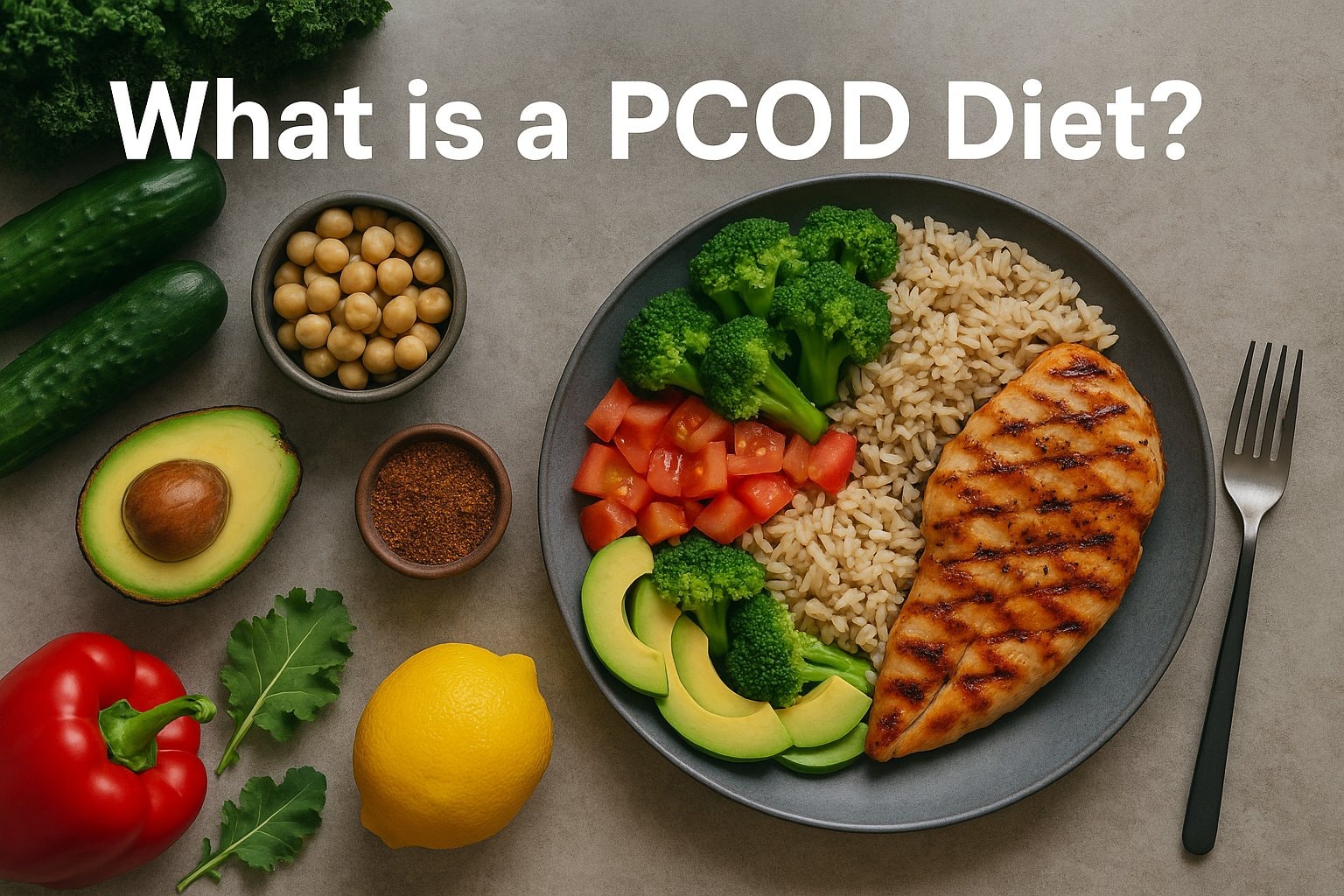
A PCOD diet is a meal plan designed for women with polycystic ovarian disease. PCOD affects hormones, weight, and how your body uses insulin.
High male hormones in PCOD can lead to acne, irregular periods, and weight gain, but diet can help control them. A healthy diet helps in managing pcod symptoms like irregular periods, weight gain, and tiredness.
Why Does It Matter for Weight Management?
Weight control is harder for pcod patients because of insulin resistance. This means the body struggles to use insulin properly, which can raise blood sugar and cause weight gain.
A balanced diet helps in managing insulin resistance and fix this. A balanced PCOD diet helps regulate hormones and keeps energy steady throughout the day.
-
A pcod diet plan with more fiber improves insulin sensitivity.
-
Eating anti inflammatory foods like fatty fish and green tea reduces swelling in the body.
-
Avoiding processed foods and sugary foods lowers cravings and supports healthy weight.
Quick Tip: If you want to lose weight with PCOD, focus on small, steady changes instead of crash diets. As one nutritionist explains, “Managing PCOD is not about eating less, but about eating smart.”
Step-by-Step Guide: PCOD Diet Chart for Weight Loss
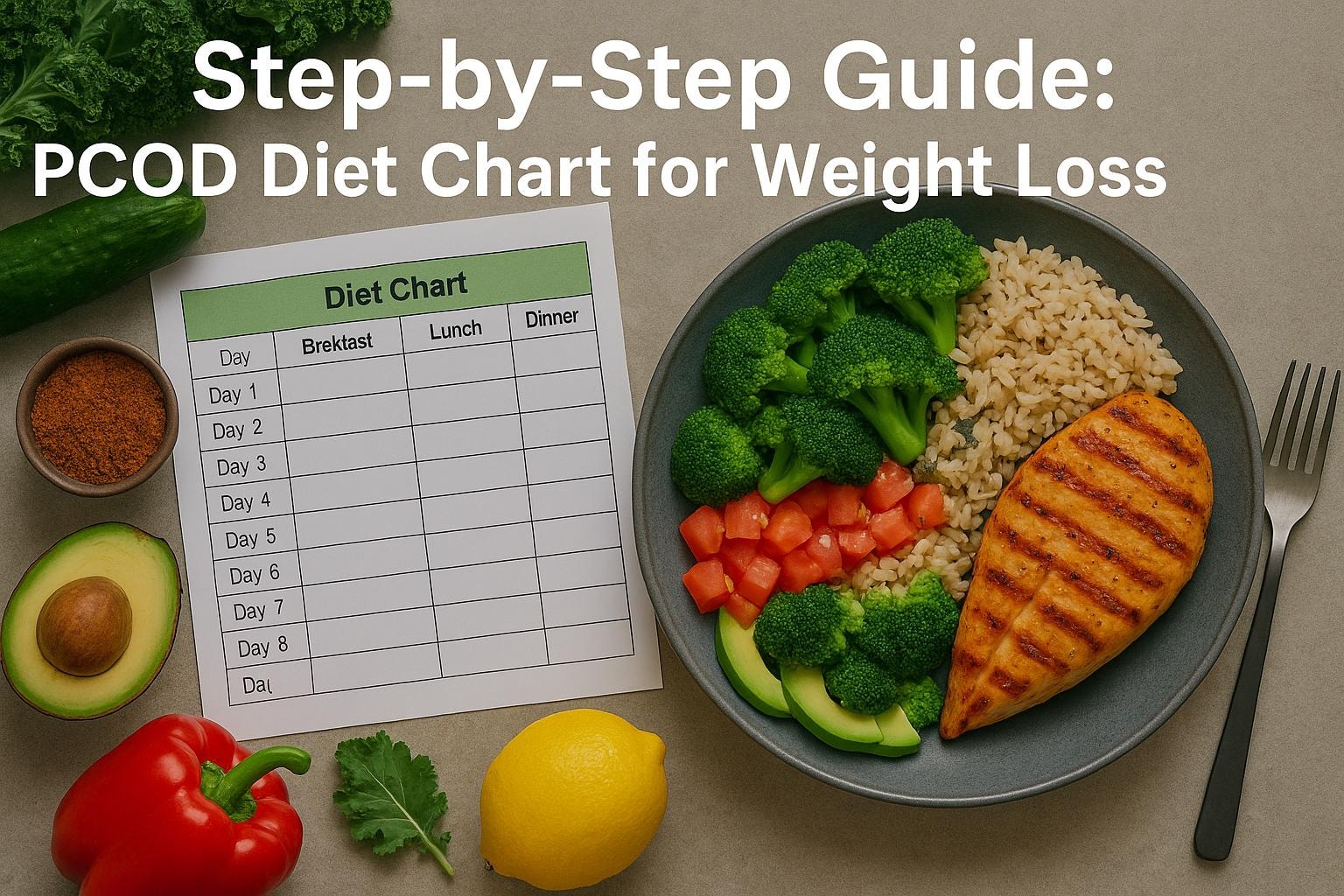
1. Start Your Day Right
-
Warm water with lemon or green tea to boost metabolism
-
Avoid energy drinks and sugary foods in the morning
2. Balanced Breakfast (8:00–9:00 am)
-
2 boiled eggs / lean proteins like paneer or tofu
-
1 bowl of brown rice poha or whole grains like oats
-
Almond milk smoothie with chia seeds
3. Mid-Morning Snack (11:00 am)
-
A handful of nuts (healthy fats) – almonds, walnuts
-
1 cup herbal tea or green tea
-
Seasonal fruit (low glycemic index) like apple, guava, or papaya
4. Lunch (1:00–2:00 pm)
-
1 bowl of brown rice / 2 multigrain chapatis (whole grains)
-
Grilled lean protein – chicken, fish, or legumes
-
Cooked vegetables (anti inflammatory foods) like spinach, broccoli, zucchini
-
Salad with olive oil dressing (healthy fats)
5. Evening Snack (4:00–5:00 pm)
-
Green tea with roasted chana or sprouts
-
Avoid fried foods, white bread, or sugary cereals
6. Dinner (7:30–8:30 pm)
-
Light meal: soup + stir-fried veggies
-
Grilled fatty fish or tofu for lean protein
-
1 small bowl of quinoa / millet (high fiber foods)
7. Before Bed (9:30–10:00 pm)
-
1 cup herbal tea (chamomile or tulsi)
-
Helps improve sleep, reduce hormonal imbalance, and support weight management
Foods to Eat in a PCOD Diet: Building a Balanced Plate
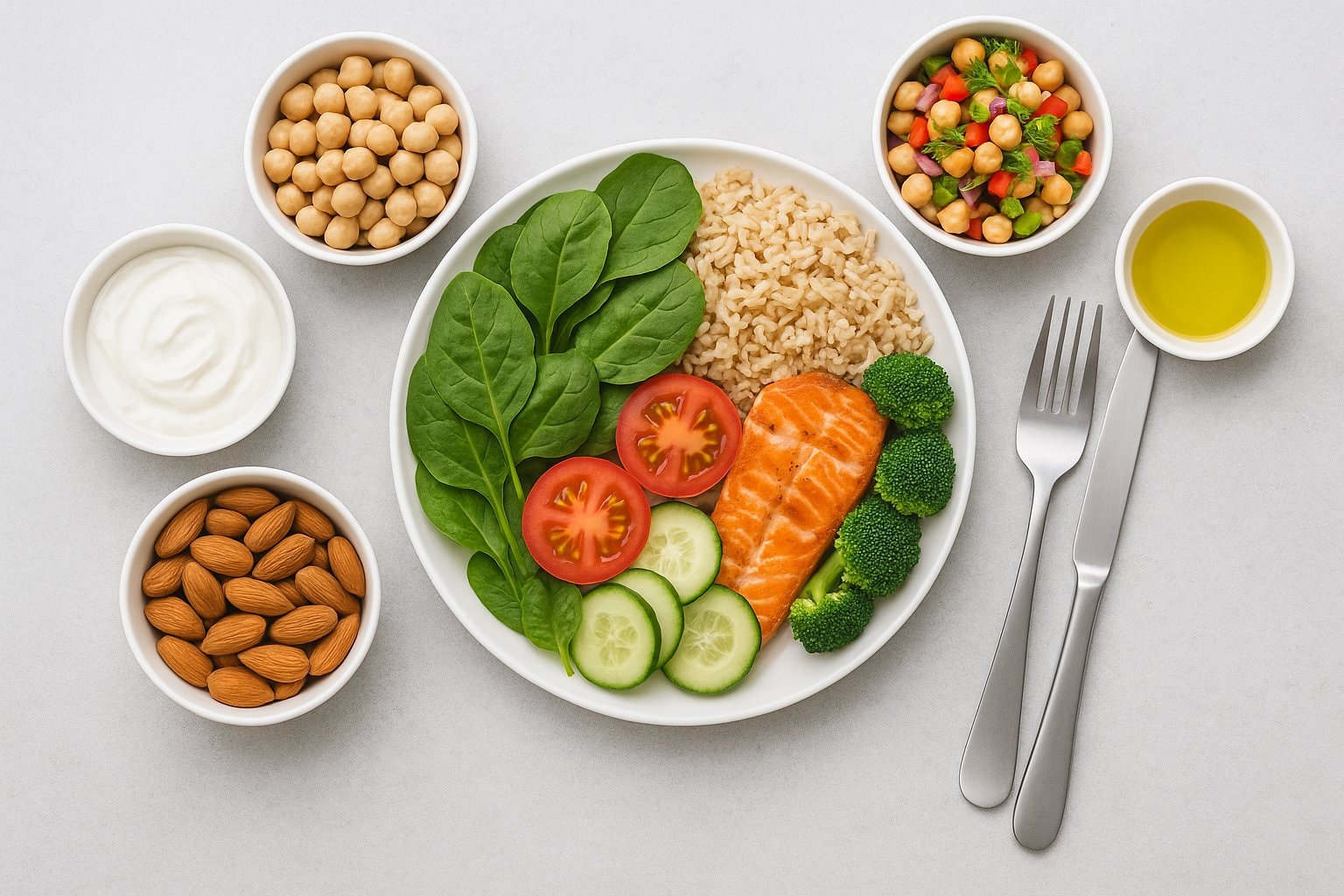
1. Lean Proteins for Satiety and Muscle Health
Protein helps you stay full, supports muscle repair, and keeps cravings away. For pcod patients, this is very important because protein reduces sugar spikes and helps improve insulin sensitivity.
Good options include:
-
Eggs and chicken (if non-vegetarian)
-
Fish like salmon or mackerel (fatty fish)
-
Plant proteins like paneer, tofu, and legumes
-
Lean protein shakes made with almond milk
Example: A grilled chicken salad or a bowl of dal with vegetables is far better than processed snacks. Nutritionists often say, “Protein is your best friend when trying to manage PCOD weight gain.”
2. Whole Grains for Steady Energy
Unlike white bread or refined carbs, whole grains break down slowly. This keeps your blood sugar steady and improves insulin resistance. A diet rich in fiber also reduces hunger and helps in weight loss.
Healthy grain choices:
-
Brown rice instead of white rice
-
Oats or quinoa for breakfast
-
Multigrain chapati or millet roti
-
Barley or buckwheat in soups
Example: Replacing white bread toast with an oat pancake can stabilize your energy through the morning.
3. Healthy Fats That Support Hormone Balance
Not all fats are bad. The right kinds—called healthy fats—help with hormone balance and reduce inflammation. For pcod management, these fats improve metabolism and aid overall health.
Best sources of healthy fats:
-
Nuts and seeds like almonds, walnuts, and chia seeds
-
Olive oil for cooking and salads
-
Avocados as a snack or topping
-
Soy milk or almond milk instead of full-fat dairy
Example: Drizzling olive oil over vegetables or adding nuts to a smoothie provides good fats without extra sugar.
4. High Fiber Foods for Blood Sugar Control
Fiber slows digestion. This means sugar enters your blood more slowly, helping to balance blood sugar levels and avoiding spikes. For women with PCOD and insulin resistance, this is very important.
Examples of high fiber foods include:
-
Vegetables like spinach, broccoli, and carrots
-
Fruits such as apples, guava, and pears
-
Whole grains like oats and brown rice
-
Seeds like flax and chia
Quick tip: Swap white bread with multigrain chapati or barley roti. This helps stabilise blood sugar and supports weight loss.
5. Anti-Inflammatory Foods to Reduce Symptoms
Many pcod symptoms—like irregular periods, fatigue, and weight gain—are linked to inflammation. Eating anti inflammatory foods can help support gut health .
Best options include:
-
Fatty fish like salmon and sardines
-
Berries, tomatoes, and leafy greens
-
Nuts and olive oil
-
Turmeric and ginger in cooking
Example: A bowl of grilled fish with veggies cooked in olive oil not only tastes good but also helps reduce inflammation.
6. Green Tea & Herbal Teas for Metabolism Boost
Simple drinks can make a big difference. Green tea and herbal teas improve metabolism, support weight control, and lower insulin levels.
Great choices:
-
Green tea twice a day to improve fat burning
-
Tulsi or chamomile herbal teas to reduce stress
-
Ginger or peppermint tea for better digestion
Small swap: Replace energy drinks with green tea. You’ll save calories and avoid sugar spikes.
7. Dairy Alternatives for Better Digestion
Many pcod patients feel bloated or uneasy after drinking regular milk. This is because dairy can sometimes affect hormonal balance and make pcod symptoms like acne or weight gain worse. A smart pcod diet includes lighter options that are easier to digest.
Better dairy alternatives are:
-
Almond milk – rich in calcium and low in calories
-
Soy milk – a good source of lean proteins and supports hormone balance
-
Coconut milk – light, tasty, and good for smoothies
Example: Replace your morning coffee creamer with almond milk. It feels the same, but your stomach will thank you.
“Join 200+ Families Who Transformed with Balance Bite’s Clinical Nutrition Plans”
Foods to Avoid in PCOD Problem: What Sabotages Hormone Balance
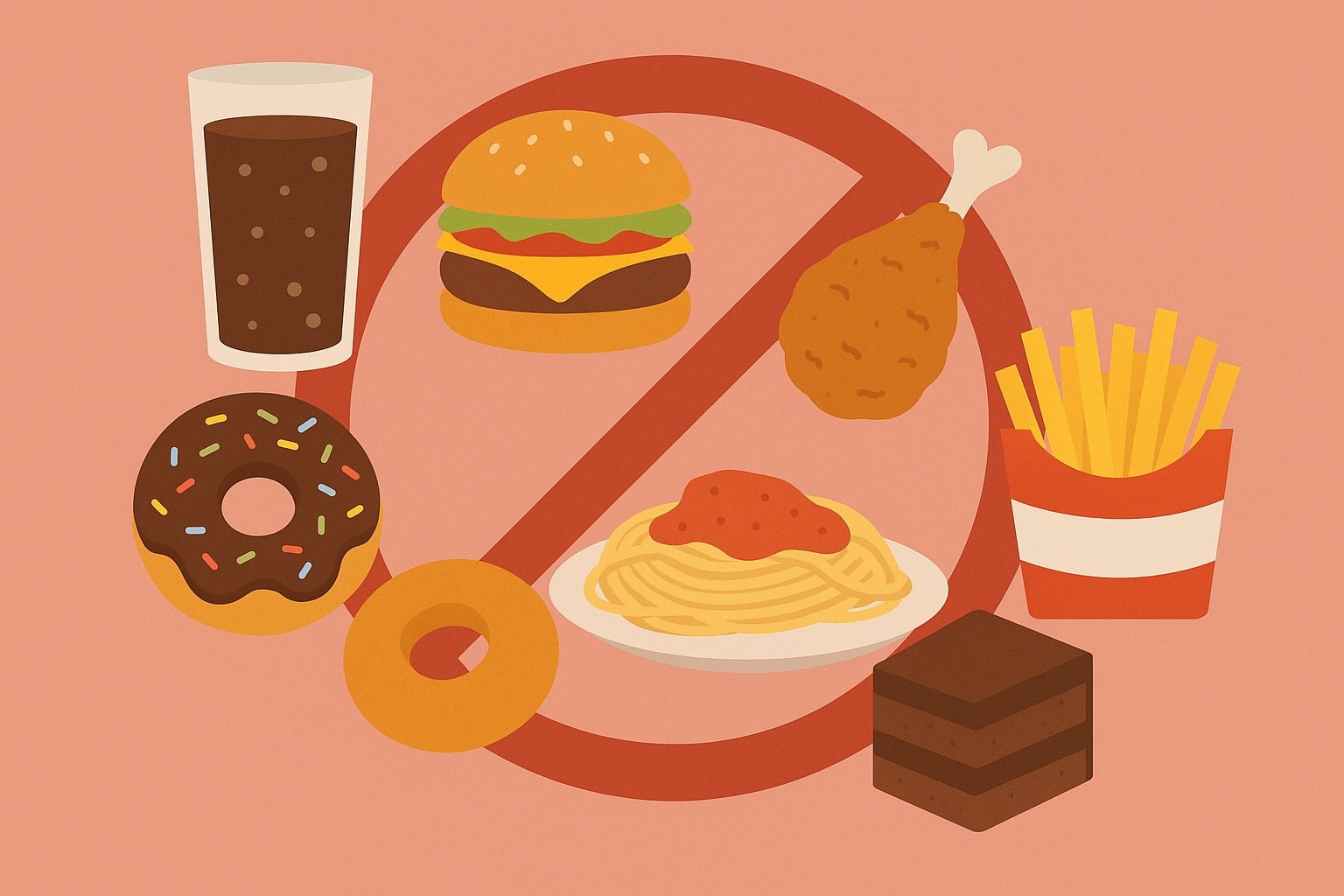
1. Sugary Foods and Drinks
Too much sugar raises insulin levels and makes insulin resistance worse. This leads to cravings and poor weight control.
Foods to avoid:
-
Candy, cakes, pastries
-
Sodas and sweetened juices
-
Hidden sugars in sauces and flavored yogurts
Quick tip: Swap a soda for green tea or herbal teas. You’ll save calories and help regulate blood sugar.
2. Refined Carbohydrates
Refined carbs break down fast and act like sugar in the body. They spike blood sugar, increase hunger, and make pcod management harder.
Foods to avoid:
-
White bread, white rice, and pasta
-
Sugary cereals
-
Processed baked goods
Try brown rice or multigrain chapati instead. These have fiber that improves insulin sensitivity.
3. Processed Foods and Packaged Snacks
Processed foods are often high in salt, sugar, and trans fats. They cause inflammation and worsen hormonal imbalances.
Foods to avoid:
-
Chips, fries, and instant noodles
-
Packaged cookies or crackers
-
Ready-to-eat frozen meals
Small story: One PCOD patient I spoke to swapped her evening chips for roasted chana and noticed fewer sugar crashes within two weeks.
4. Fried Foods
Fried snacks may taste good, but they’re loaded with unhealthy oils and trans fats. These cause inflammation and lead to weight gain.
Foods to avoid:
-
French fries
-
Deep-fried pakoras or samosas
-
Fried chicken or chips
5. Sugary Cereals
Many breakfast cereals look “healthy,” but they are full of hidden sugar. They raise blood sugar levels quickly and cause hunger soon after.
Foods to avoid:
-
Sweet cornflakes
-
Chocolate-coated cereals
-
Instant flavored oats
Try starting your day with oats, quinoa, or a bowl of fruits instead. This keeps energy steady and helps in weight management.
6. Energy Drinks and Excess Caffeine
Energy drinks and too much coffee overstimulate your body. They spike insulin levels, disturb sleep, and increase stress hormones.
Drinks to avoid:
-
Packaged energy drinks
-
Sugary cold coffees
-
Multiple cups of strong tea or coffee
Experts suggest moderate caffeine consumption instead of relying on energy drinks or multiple cups of coffee.
7. Full-Fat Dairy (in Excess)
Dairy is not bad for everyone, but too much full-fat milk or cheese may worsen acne and hormonal imbalance in some pcod patients.
Foods to limit:
-
Whole milk in large amounts
-
Cream and butter
-
Cheese-heavy meals
Healthier swaps include almond milk or soy milk.
How PCOD Diet Helps Manage Blood Sugar and Insulin Resistance
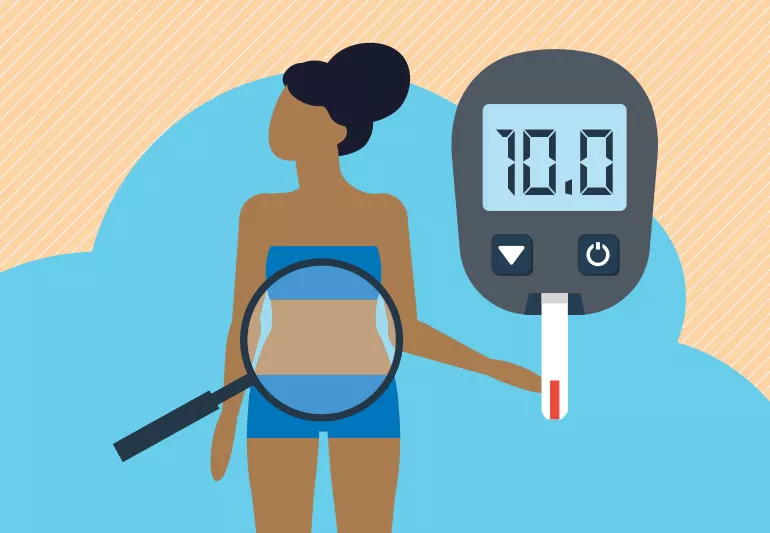
-
Stabilizes Blood Sugar Levels: When you eat whole grains, brown rice, and high fiber foods, sugar enters your blood slowly. This prevents sudden spikes and crashes. Stable sugar levels mean more energy and fewer mood swings.
-
Improves Insulin Sensitivity: Lean proteins and healthy fats like olive oil, nuts, and seeds help your body use insulin better. This improves insulin sensitivity, which is key for pcod patients struggling with weight gain.
-
Reduces Inflammation Linked to Insulin Resistance: Anti inflammatory foods such as fatty fish, turmeric, and green leafy vegetables reduce swelling in the body. Less inflammation makes it easier to manage pcod symptoms and supports hormone balance.
-
Controls Cravings and Weight Gain: Eating balanced meals with protein and fiber helps you stay full longer. This reduces cravings for sugary foods and processed snacks. As a result, you avoid unhealthy weight gain and move closer to healthy weight management.
-
Manages PCOD Symptoms: A structured pcod diet chart supports more than weight control. It helps reduce irregular periods, improves skin health, and boosts energy. Some PCOD patients also deal with excessive hair growth, which can be managed better with healthy nutrition.
Daily PCOD Management: Practical Lifestyle & Diet Tips

-
Follow a Structured PCOD Diet Chart: A planned pcod diet chart keeps your meals balanced and prevents overeating. Eating at fixed times helps manage insulin resistance and improves energy. Start with breakfast, include healthy snacks, and avoid long gaps between meals.
-
Prioritize Whole, Natural Foods: Choose whole grains, brown rice, fresh fruits, and vegetables. These foods have fiber, which stabilizes blood sugar and reduces cravings. Avoid processed foods, fried foods, and sugary cereals. They cause sudden sugar spikes and make pcod symptoms worse.
-
Balance Hormones with Smart Choices: Adding lean proteins, healthy fats, and anti inflammatory foods supports better hormone balance. For example, grilled fish with olive oil or nuts with green tea are simple meals that fight inflammation.
-
Stay Hydrated with Healthy Drinks: Swap energy drinks and excess caffeine with green tea or herbal teas. These boost metabolism and help in weight loss. Even almond milk or soy milk are better choices than sugary drinks.
-
Practice Portion Control for Weight Management: Eating too much—even healthy food—can lead to weight gain. Use small plates, measure portions, and chew slowly. Research shows that portion control improves both insulin sensitivity and weight control in pcod patients.
-
Lifestyle Tweaks Beyond Diet: Exercise regularly—walking, yoga, or strength training work well. Sleep at least 7–8 hours. Poor sleep can disturb hormones and raise insulin levels. Stress management also plays a big role in pcod management.
-
Track and Adjust Regularly: Every woman is different. Track your meals, weight, and pcod symptoms. Adjust your pcod diet plan based on what works for you. As one nutritionist says, “Managing PCOD is about consistency, not perfection.”
“Get a Personalized PCOD Diet Plan + Premium Groceries Delivered to Your Doorstep with Balance Bite”
PCOD Diet FAQs: Real Questions from PCOD Patients

1. Can a pcos diet chart or pcos diet plan work for PCOD too?
Yes. A pcos diet chart or pcos diet plan works for PCOD patients as well. Both conditions involve hormonal imbalance and insulin resistance. The same foods—whole grains, lean proteins, healthy fats, and high fiber foods—help manage symptoms.
Example: A bowl of oats with almond milk and chia seeds works equally well for women with PCOD or PCOS.
According to the Indian Journal of Endocrinology and Metabolism (2022), lifestyle and diet changes are the first line of treatment for both PCOS and PCOD.
2. Do I need to drink milk or avoid it in a PCOD diet?
It depends. Some pcod patients tolerate dairy well, while others feel bloated or notice skin issues. If milk bothers you, switch to almond milk or soy milk. These options provide protein and calcium without affecting hormone balance.
Quick tip: Try replacing your morning coffee creamer with almond milk for a week and track how your body feels.
3. How fast can I lose weight with a proper pcod diet chart?
Weight loss with PCOD takes time. A balanced pcod diet chart with whole grains, green tea, and anti inflammatory foods may help you lose 0.5–1 kg per week if followed with exercise. Crash diets don’t work and may worsen hormonal imbalances.
Remember: Slow and steady weight loss supports long-term weight management.
A study in the Journal of Human Nutrition and Dietetics (2021) found that women with PCOD who followed a structured diet and exercise program lost more weight than those who tried quick fixes.
4. Is there a role of herbal teas and reduce inflammation naturally?
Yes. Herbal teas like chamomile, peppermint, and tulsi reduce stress and improve digestion. Green tea helps lower insulin levels and supports fat burning. Teas with ginger or turmeric act as anti inflammatory foods, reducing pcod symptoms such as irregular periods and fatigue.
Conclusion
A smart pcod diet can help you manage pcod symptoms, improve blood sugar levels, and support hormonal balance.
Adding high fibre foods, choosing balanced nutrition, and limiting processed or fast food makes a big difference. For some pcod patients, switching to almond or soy milk supports better digestion and overall health.
Stay consistent with your pcod diet chart and adjust as needed. Small daily choices can lead to lasting results and a healthier, more balanced life. Following a PCOD diet improves insulin sensitivity and supports a healthy pregnancy in the future.




















Leave a comment
Translation missing: en.blogs.comments.discription